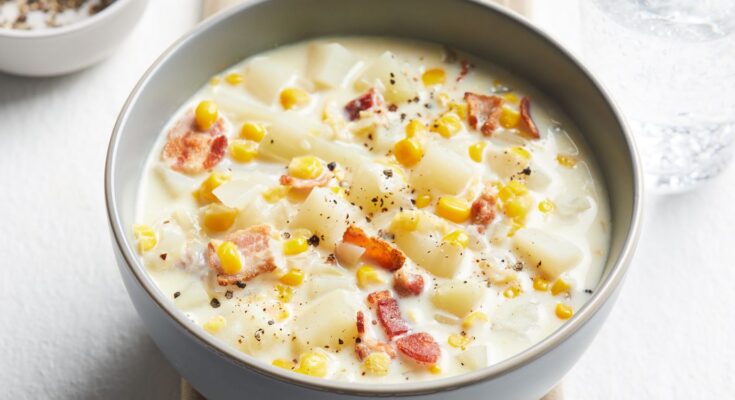Corn Chowder Recipe: Corn chowder is a comforting, creamy soup that’s rich in flavor and packed with hearty vegetables, tender potatoes, and sweet corn.
Originally popularized in New England, this chowder has become a staple in kitchens worldwide for its satisfying, filling qualities and its versatility.
This recipe will guide you through each step to make a delicious, thick chowder that’s perfect for any season, with fresh summer corn or canned corn as an option.
Ingredients for Corn Chowder
- Corn kernels – 2 cups (fresh, canned, or frozen)
- Potatoes – 2 medium, peeled and diced
- Onion – 1 medium, finely chopped
- Celery – 1-2 stalks, diced
- Carrot – 1 medium, diced
- Garlic – 2 cloves, minced
- Butter – 3 tablespoons
- All-purpose flour – 2 tablespoons
- Vegetable or chicken broth – 4 cups
- Heavy cream or half-and-half – 1 cup
- Salt and pepper – to taste
- Fresh thyme – 1 teaspoon (optional)
- Paprika – 1/2 teaspoon (optional, for a smoky flavor)
Optional Add-ins: Bacon bits, shredded cheese, or fresh herbs for garnish.
Preparation Tips
- Selecting Corn: Fresh corn brings the most flavor, especially when in season. To prepare, shave off the kernels and reserve the cobs to add extra flavor to the broth. If using canned or frozen corn, drain and rinse to remove excess salt or preservatives.
- Other Vegetables: Onion, celery, and carrots are traditional choices that add depth to the chowder. Adjust their quantities to your preference for sweetness or crunch.
Step-by-Step Corn Chowder Recipe
Step 1: Prepare the Ingredients
Start by preparing all your vegetables. Peel and dice the potatoes into small cubes, finely chop the onion, dice the celery and carrot, and mince the garlic. If using fresh corn, slice off the kernels and set them aside. Having everything ready to go before cooking will streamline the process and ensure each ingredient is cooked perfectly.
Step 2: Sauté the Vegetables
In a large pot, melt the butter over medium heat. Add the chopped onion, celery, and carrot, and sauté for about 5-7 minutes until they soften and start to turn translucent. Add minced garlic and cook for an additional 1-2 minutes, being careful not to burn it. Sautéing enhances the sweetness of these vegetables, which will form the base of the chowder’s flavor.
Step 3: Add Flour and Seasonings
Sprinkle the flour over the sautéed vegetables, stirring constantly for about 2-3 minutes. The flour helps thicken the chowder, giving it that creamy texture. Add in the salt, pepper, paprika, and thyme, if using, mixing well to coat the vegetables and evenly distribute the seasonings.
Step 4: Add Broth and Potatoes
Pour in the broth, stirring constantly to incorporate the flour without clumps. Add the diced potatoes and bring the mixture to a boil, then reduce the heat to a simmer. Let it cook for 10-15 minutes or until the potatoes are tender. Using a vegetable broth will keep the recipe vegetarian, while chicken broth adds a deeper flavor.
Step 5: Cook Until Tender
Simmer the chowder, stirring occasionally, until the potatoes are soft when pierced with a fork. This step typically takes about 15 minutes. Allowing the potatoes to become tender will give the chowder a creamy texture, as some of the potato will naturally break down and thicken the soup.
Step 6: Add Corn and Cream
Once the potatoes are tender, add the corn kernels and heavy cream (or half-and-half) to the pot. Stir well to combine, allowing the corn to heat through and the cream to mix fully with the broth. The addition of corn at this stage keeps it sweet and crisp, giving the chowder a delightful texture contrast. If you’re using fresh corn, you’ll get a brighter flavor, but canned or frozen corn works well, too.
Step 7: Simmer and Adjust Consistency
Lower the heat and let the chowder simmer gently for another 5-10 minutes. This extra simmering time melds the flavors of the corn, potatoes, and creamy broth. If you prefer a thicker chowder, let it cook a few minutes longer to reduce slightly. For a thinner consistency, you can add a bit more broth or milk to the pot until it reaches your desired texture.
Step 8: Taste and Adjust Seasonings
Now it’s time to taste your chowder and make any final adjustments to the seasoning. Add salt and pepper as needed. If you enjoy a bit of heat, consider adding a pinch of cayenne pepper or red pepper flakes. Fresh herbs like chopped parsley or thyme can also brighten the flavor. Tasting at this step ensures your chowder is perfectly balanced and delicious.
Step 9: Garnish and Serve
When your chowder is ready, ladle it into bowls and add your favorite garnishes. Popular options include:
- Chopped chives or parsley for a fresh pop of color.
- Crispy bacon bits for added savory crunch.
- Shredded cheese, like sharp cheddar, to make the chowder extra rich.
- A sprinkle of paprika or smoked paprika for a hint of color and depth.
Corn chowder pairs wonderfully with crusty bread or a green salad. Serve it hot for a cozy meal that’s satisfying and comforting.
Tips for Storing Leftover Corn Chowder
To store leftover chowder:
- Refrigerate: Transfer to an airtight container and refrigerate for up to 3-4 days.
- Freeze: Place chowder in freezer-safe containers or bags, leaving some room for expansion. It can be frozen for up to 2 months. Note that the cream may separate slightly upon thawing, but reheating slowly and stirring well can help restore the texture.
Reheating: For best results, reheat chowder on the stove over medium-low heat, stirring occasionally. Avoid boiling, as this can cause the cream to curdle.
Health Benefits of Corn Chowder
Corn chowder isn’t just delicious—it’s packed with nutritious ingredients! Here are some benefits:
- Corn: Rich in fiber, vitamin C, and antioxidants, corn supports digestion and immune health.
- Potatoes: Potatoes add complex carbs, vitamin C, and potassium, aiding energy and heart health.
- Vegetables: Onion, garlic, celery, and carrots offer a wealth of nutrients, including vitamin K, antioxidants, and anti-inflammatory properties.
To make it lighter, consider swapping cream for milk or using a smaller amount of butter. You can also increase the veggie-to-potato ratio for a lower-carb option.
FAQs about Corn Chowder Recipe
1. Can I make corn chowder without dairy?
Yes! Substitute the cream with coconut milk or almond milk for a dairy-free version. You can also skip the butter and use olive oil or a dairy-free alternative.
2. What can I serve with corn chowder?
Corn chowder pairs well with crusty bread, biscuits, or a simple green salad. For a heartier meal, try serving it with grilled cheese sandwiches or a side of roasted vegetables.
3. Can I make corn chowder vegan?
Absolutely. Use vegetable broth, replace butter with vegan margarine or oil, and substitute cream with a plant-based option like coconut milk. Vegan corn chowder can be just as creamy and flavorful!
4. How do I thicken corn chowder if it’s too thin?
If your chowder is too thin, let it simmer uncovered for a bit longer to reduce. You can also mash some of the potatoes or add a slurry of flour and water for extra thickness.
5. Can I add other vegetables to the chowder?
Yes! Many people enjoy adding bell peppers, zucchini, or even tomatoes for extra flavor and nutrients. Just chop them finely and add along with the other vegetables during the sautéing step.
Conclusion
Making corn chowder from scratch is a rewarding process that results in a creamy, hearty soup packed with the natural sweetness of corn and the comforting richness of cream. With easy-to-find ingredients and flexible steps, this chowder can be customized to fit your tastes, whether you prefer it vegetarian, spiced up, or even garnished with extra toppings. So grab a pot, gather your ingredients, and enjoy this delightful chowder that’s perfect for any cozy meal!



